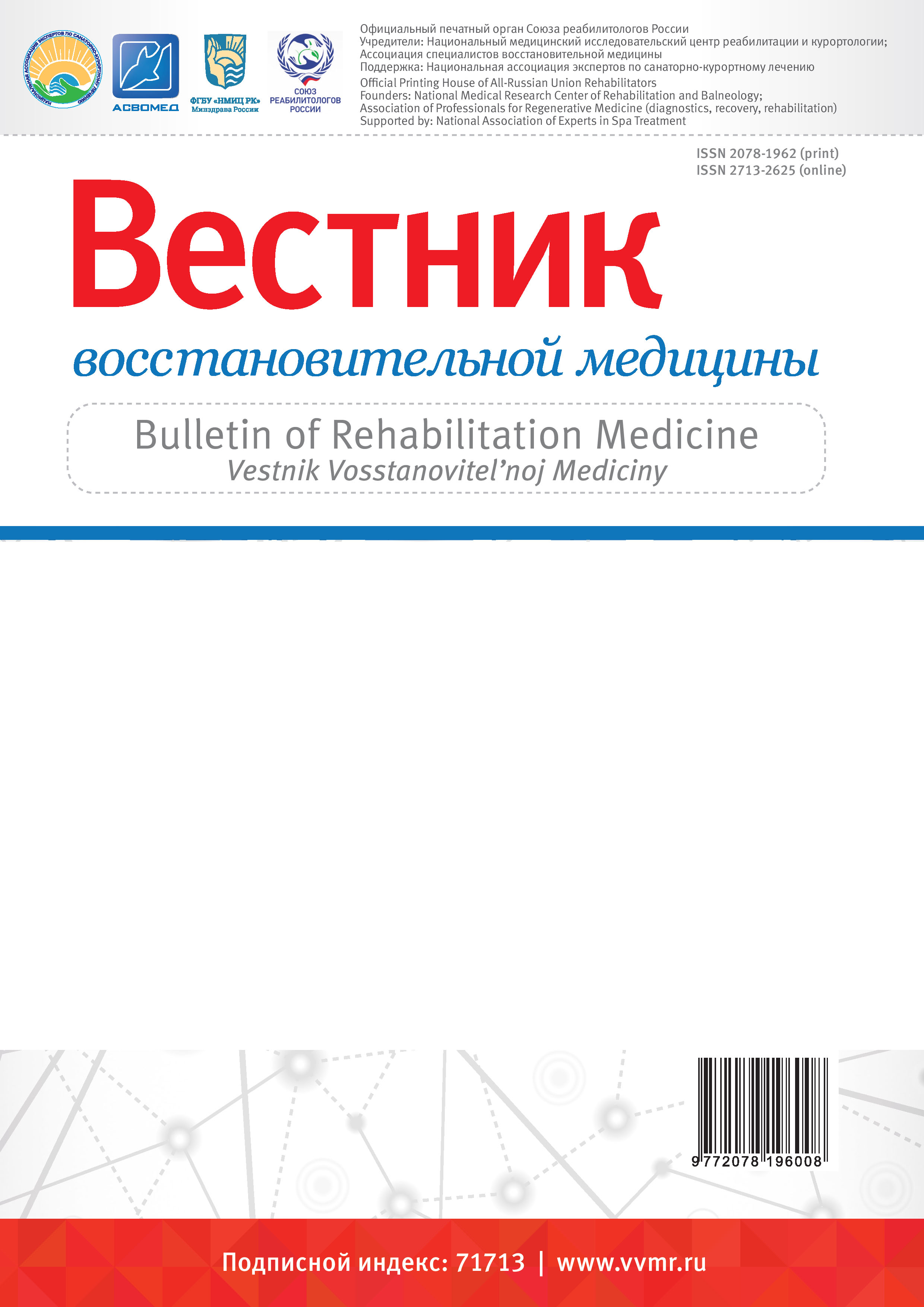This review examines data from modern scientific periodicals on various approaches to physical rehabilitation using aerobic work in patients with common diseases preceding severe cardiovascular pathologies, namely, with dyslipidemia and arterial hypertension. Dyslipidemia in patients is determined by the indicators of the blood serum lipid profile, which reflects disturbances in metabolic processes in the systems and organs of the body. The aim of our integrative review was to identify and bring together already known physical rehabilitation parameters that need to be considered in order to achieve maximum benefit in normalizing blood pressure and blood lipid profile. The randomized controlled trials and meta-analyzes review search was conducted in the electronic biomedical research databases: MEDLINE (PubMed), eLibrary, EMBASE, CINAHL, Web of Science, and Cochrane. As a result of the analysis, the following parameters amenable to modification were identified: exercise intensity (low, medium, high), determined by the percentage of the maximum heart rate or the performed work severity subjective assessment; aerobic training techniques (high-intensity interval training, uniform medium-intensity training); external factors (ambient temperature during training) influencing the physiological adaptations of the body (hyperthermia, lipolysis - secretion of free fatty acids) of the study participant; a type of exercise according to the amount of skeletal muscle body mass involved (muscles of the upper and muscles of the lower extremities); the optimal amount of aerobic physical activity, expressed in terms of caloric expenditure per week; the duration of the physical rehabilitation period (from 3 months); the initial level of markers of the blood lipid profile before therapy; an increased body mass index of patients due to an excess of the fat component; adherence to a healthy lifestyle (quitting smoking, limiting alcohol). In conclusion, all previously reflected parameters need to be considered when modeling the physical rehabilitation protocol, as well as in the future randomized controlled trials.
lipidnyy profil' krovi, arterial'naya gipertenziya, holesterin, aerobnaya rabota, fizicheskaya reabilitaciya, interval'naya trenirovka
1. Aronov D.M., Ioseliani D.G., Bubnova M.G., Krasnickiy V.B., Grinshteyn Yu.I., Gulyaeva S.F., Efremushkin G.G., Lyamina N.P. Rezul'taty rossiyskogo randomizirovannogo kontroliruemogo klinicheskogo issledovaniya po ocenke klinicheskoy effektivnosti kompleksnoy godichnoy programmy reabilitacii s vklyucheniem fizicheskih trenirovok u trudosposobnyh bol'nyh, perenesshih ostryy infarkt miokarda na fone arterial'noy gipertonii. Vestnik vosstanovitel'noy mediciny. 2017; 5(81): 2-11.
2. Boycov S.A., Ivanova G.E., Rogoza A.N., Gercik Yu.G., Gercik G.Ya. Analiz metodov i tehnicheskih resheniy dlya izmereniya arterial'nogo davleniya s primeneniem telemedicinskih tehnologiy pri kardiologicheskih issledovaniyah v processe medicinskoy reabilitacii. Vestnik vosstanovitel'noy mediciny. 2018; 6(88): 91-95.
3. Davydov S.O., Stepanov A.V., Kuznik B.I., Guseva E.S. Vliyanie kineziterapii na uroven' adgezivnoy molekuly jam-a u bol'nyh gipertonicheskoy bolezn'yu. Vestnik vosstanovitel'noy mediciny. 2017; 5(81): 33-37.
4. Tarasevich A.F. Novye vozmozhnosti uvelicheniya priverzhennosti pacientov k modifikacii obraza zhizni. Vestnik vosstanovitel'noy mediciny. 2017; 1(77): 63-71.
5. Thakushinov R.A., Lysenkov S.P., Dautov Yu.Yu., Urakova T.Yu. Razgruzochno-dieticheskaya terapiya v kompleksnom lechenii i profilaktike bol'nyh arterial'noy gipertoniey i ozhireniem. Vestnik vosstanovitel'noy mediciny. 2017; 5(81): 45-51.
6. Wood G., Murrell A., van der Touw T., Smart N. HIIT is not superior to MICT in altering blood lipids: a systematic review and meta-analysis. BMJ Open Sport & Exercise Medicine. 2019; 5(1): e000647 p. https://doi.org/10.1136/bmjsem-2019-000647
7. Orozco-Beltran D., Gil-Guillen V.F., Redon J., Martin-Moreno J.M., Pallares-Carratala V., Navarro-Perez J., Valls-Roca F., Sanchis-Domenech C., Fernandez-Gimenez A., Perez-Navarro A., Bertomeu-Martinez V., Bertomeu-Gonzalez V., Cordero A., Pascual de la Torre M., Trillo J.L., Carratala-Munuera C., Pita-Fernandez S., Uso R, Durazo-Arvizu R., Cooper R., Sanz G, Castellano J.M., Ascaso J.F., Carmena R., Tellez-Plaza M. ESCARVAL Study Group. Lipid profile, cardiovascular disease and mortality in a Mediterranean high-risk population: The ESCARVAL-RISK study. PLoS One. 2017; 12(10): e0186196 p. https://doi.org/10.1371/journal.pone.0186196
8. Ostman C., Smart N.A., Morcos D., Duller A., Ridley W., Jewiss D. The effect of exercise training on clinical outcomes in patients with the metabolic syndrome: a systematic review and meta-analysis. Cardiovascular Diabetology. 2017; 16(1): 110 p. https://doi.org/10.1186/s12933-017-0590-y
9. Gordon B., Chen S., Durstine J.L. The effects of exercise training on the traditional lipid profile and beyond. Current Sports Medicine Reports. 2014; 13(4): 253-259. https://doi.org/10.1249/JSR.0000000000000073
10. Plaisance E.P., Grandjean P.W., Mahurin A.J. Independent and combined effects of aerobic exercise and pharmacological strategies on serum triglyceride concentrations: a qualitative review. Phys Sportsmed. 2009; 37(1): 11-19. https://doi.org/10.3810/psm.2009.04.1678
11. Mayo Clinic. High cholesterol. Available at: http://www.mayoclinic.org/diseases-conditions/high-bloodcholesterol/diagnosis-treatment/diagnosis/dxc-20350806. (accessed May 14, 2021).
12. Norton K., Norton L., Sadgrove D. Position statement on physical activity and exercise intensity terminology. Journal of Science and Medicine in Sport. 2010; 13(5): 496-502. https://doi.org/10.1016/j.jsams.2009.09.008
13. Seiler S., Intervals T.E. Thresholds, and long slow distance: the role of intensity and duration in endurance training. Sport Science. 2019; (13): 32-53.
14. Kraus W.E., Houmard J.A., Duscha B.D., Knetzger K.J., Wharton M.B., McCartney J.S., Bales C.W., Henes S., Samsa G.P., Otvos J.D., Kulkarni K.R., Slentz C.A. Effects of the amount and intensity of exercise on plasma lipoproteins. The New England Journal of Medicine. 2002; 347(19): 1483-92. https://doi.org/10.1056/NEJMoa020194
15. Liang H., Luo S., Chen X., Lu Y., Liu Z., Wei L. Effects of Tai Chi exercise on cardiovascular disease risk factors and quality of life in adults with essential hypertension: A meta-analysis. Heart & Lung. 2020; 49(4): 353-363. https://doi.org/10.1016/j.hrtlng.2020.02.041
16. Aghaei Bahmanbeglou N., Ebrahim K., Maleki M., Nikpajouh A., Ahmadizad S. Short-Duration High-Intensity Interval Exercise Training Is More Effective Than Long Duration for Blood Pressure and Arterial Stiffness But Not for Inflammatory Markers and Lipid Profiles in Patients With Stage 1 Hypertension. Journal of Cardiopulmonary Rehabilitation and Prevention. 2019; 39(1): 50-55. https://doi.org/10.1097/HCR.0000000000000377
17. Elmer D.J., Laird R.H., Barberio M.D., Pascoe D.D. Inflammatory, lipid, and body composition responses to interval training or moderate aerobic training. European Journal of Applied Physiology. 2016; 116(3): 601-609. https://doi.org/10.1007/s00421-015-3308-4
18. Hartung G., da Cunha Nascimento D., de Sousa N.M.F. Enhancing of women functional status with metabolic syndrome by cardioprotective and anti-inflammatory effects of combined aerobic and resistance training. PLoS One. 2014; 9(11): e110160. https://doi.org/10.1371/journal.pone.0110160
19. Lee M.S., Pittler M.H., Ernst E. Tai chi for osteoarthritis: a systematic review. Clinical Rheumatology. 2008; 27(2): 211-218. https://doi.org/10.1007/s10067-007-0700-4
20. Taylor-Piliae R.E., Froelicher E.S. The effectiveness of Tai Chi exercise in improving aerobic capacity: A metaanalysis. Journal of Cardiovascular Nursing. 2004; (19): 48-57. https://doi.org/10.1097/00005082-200401000-00009
21. Koh T. Baduanjin-an ancient Chinese exercise. The American Journal of Chinese Medicine. 1982; 10(01n04): 14-21. https://doi.org/10.1142/S0192415X8200004X
22. Ainsworth B.E., Haskell W.L., Whitt M.C., Irwin M.L., Swartz A.M., Strath S.J., O'Brien W.L., Bassett Dr.Jr., Schmitz K.H., Emplaincourt P.O., Jacobs Dr.Jr., Leon A.S. Compendium of physical activities: An update of activity codes and MET intensities. Medicine & Science in Sports & Exercise. 2000; 32(9): S498-S504. https://doi.org/10.1097/00005768-200009001-00009
23. de Souza Filho Z.A., Ferreira A.A., Dos Santos J., Meira K.C., Pierin A.M.G. Cardiovascular risk factors with an emphasis on hypertension in the Mura Indians from Amazonia. BMC Public Health. 2018; (18): 1251 p. https://doi.org/10.1186/s12889-018-6160-8
24. Rivas E., Crandall C.G., Suman O.E., Moustaid-Moussa N., Ben-Ezra V. Exercise heat acclimation causes post-exercise hypotension and favorable improvements in lipid and immune profiles: A crossover randomized controlled trial. Journal of Thermal Biology. 2019; (84): 266-273. https://doi.org/10.1016/j.jtherbio.2019.07.017
25. Nordmann A.J., Nordmann A., Briel M., Keller U., Yancy W.S., Brehm B.J., Bucher H.C. Effects of low-carbohydrate vs low-fat diets on weight loss and cardiovascular risk factors: a meta-analysis of randomized controlled trials. JAMA Internal Medicine. 2006; 166(3): 285-293. https://doi.org/10.1001/archinte.166.3.285
26. O'Hearn K., Tingelstad H.C., Blondin D., Tang V., Filion L.G., Haman F. Heat exposure increases circulating fatty acids but not lipid oxidation at rest and during exercise. Journal of Thermal Biology. 2016; (55): 39-46. https://doi.org/10.1016/j.jtherbio.2015.11.002
27. Lee J.B., Kim T.W. Increased levels of FFA during passive heat loading after a 2-week repeated heat load in Koreans. International Journal of Biometeorology. 2015; 59(4): 473-475. https://doi.org/10.1007/s00484-014-0849-x
28. Wang Y., Shen L., Xu D. Aerobic exercise reduces triglycerides by targeting apolipoprotein C3 in patients with coronary heart disease. Clinical Cardiology. 2019; 42(1): 56-61. https://doi.org/10.1002/clc.23104
29. Goldberg A.C., Hopkins P.N., Toth P.P., Ballantyne C.M., Rader D.J., Robinson J.G., Daniels S.R., Gidding S.S., de Ferranti S.D., Ito M.K., McGowan M.P., Moriarty P.M., Cromwell W.C., Ross J.L., Ziajka P.E. National Lipid Association Expert Panel on Familial Hypercholesterolemia. Familial hypercholesterolemia: screening, diagnosis and management of pediatric and adult patients: clinical guidance from the National Lipid Association Expert Panel on Familial Hypercholesterolemia. Journal of Clinical Lipidology. 2011; 5(3): S1-S8. https://doi.org/10.1016/j.jacl.2011.04.003
30. Magkos F. Basal very low-density lipoprotein metabolism in response to exercise: mechanisms of hypertriacylglycerolemia. Progress in Lipid Research. 2009; 48(3-4): 171-190. https://doi.org/10.1016/j.plipres.2009.02.003
31. Thompson P.D., Crouse S.F., Goodpaster B., Kelley D., Moyna N., Pescatello L. The acute versus the chronic response to exercise. Medicine and Science in Sports and Exercise. 2001; 33(6): S438-S453. https://doi.org/10.1097/00005768-200106001-00012
32. Wagganer J.D., Robison C.E., Ackerman T.A., Davis P.G. Effects of exercise accumulation on plasma lipids and lipoproteins. Applied Physiology, Nutrition, and Metabolism. 2015; 40(5): 441-447. https://doi.org/10.1139/apnm-2014-0321
33. Stevens J., Truesdale K.P., McClain J.E., Cai J. The definition of weight maintenance. International Journal of Obesity. 2005; 30(3): 391-399. https://doi.org/10.1038/sj.ijo.0803175
34. Plaisance E.P., Grandjean P.W., Mahurin A.J. Independent and combined effects of aerobic exercise and pharmacological strategies on serum triglyceride concentrations: a qualitative review. The Physician and Sports Medicine. 2009; 37(1): 11-19. https://doi.org/10.3810/psm.2009.04.1678
35. Sarzynski M.A., Burton J., Rankinen T., Blair S.N., Church T.S., Després J.P., Hagberg J.M., Landers-Ramos R., Leon A.S., Mikus C.R., Rao D.C., Seip R.L., Skinner J.S., Slentz C.A., Thompson P.D., Wilund K.R., Kraus W.E., Bouchard C. The effects of exercise on the lipoprotein subclass profile: A meta-analysis of 10 interventions. Atherosclerosis. 2015; 243(2): 364-372. https://doi.org/10.1016/j.atherosclerosis.2015.10.018





